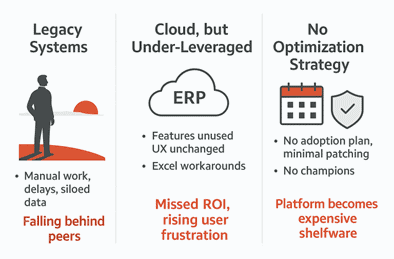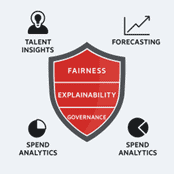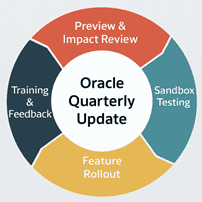Closing the Cloud Value Gap: Activate Redwood, AI & Quarterly Innovation for Real Oracle ROI
Author: Pramod Alluri | 10 min read | July 10, 2025
Why activating Redwood UI, embedded AI, and quarterly patching is critical to realizing business outcomes.
Summary
Many organizations have made the move to Oracle Cloud HCM, ERP, and EPM—but few are getting full value from their investment. This blog explores the gap between implementation and impact, why go-live is just the beginning, and how activating features like Redwood UI, embedded AI, and quarterly updates can drive measurable ROI, agility, and operational excellence.
Key Takeaways
- Why “go-live” isn’t the finish line—outcomes lag when features remain unused.
- How Redwood UI boosts adoption, improves productivity, and enhances the user experience.
- The role of embedded AI in delivering predictive insights across HCM, ERP, and EPM.
- How quarterly patching enables continuous innovation at no added licensing cost.
- Real-world examples of organizations that closed the value gap and improved KPIs post-implementation.
Implementation Isn’t the Finish Line
You’ve implemented Oracle Cloud. The systems are live, the integrations are done. But something’s missing. Teams still struggle to adopt the platform. Reports take too long. Forecasts lack real-time accuracy. And business outcomes haven’t materially changed.
This gap is what we call the Oracle Cloud Value Gap—the distance between the capabilities you’ve paid for and the impact you’re actually realizing. The good news? The tools to close this gap are already in your hands.
Why Outcomes Lag
Even with Oracle Cloud in place, many companies find their strategic outcomes stalled. Here’s why:
- Legacy Mindsets: Teams continue using manual workarounds or replicate old processes in new systems.
- Underused Features: AI, Redwood UX, and automation often go unactivated.
- Disconnected Strategy: There’s no KPI alignment between business outcomes and Oracle capabilities.
- Missed Patching Cycles: Quarterly updates introduce new features, but few organizations fully engage with them.
- Lack of Change Management: Without proper training and cultural support, adoption remains low.

Redwood UI: The Gateway to Adoption, Productivity, and Business Agility
When it comes to enterprise platforms, adoption is everything. No matter how advanced your system is, it won’t drive outcomes unless your people use it confidently and efficiently. Oracle’s Redwood UI transforms Oracle Cloud from a transactional tool into an intuitive, user-friendly experience that accelerates adoption and business productivity.
What Makes Redwood UI a Game-Changer?
- Role-Based Dashboards: Tailor dashboards by function—HR, Finance, Procurement—ensuring each user sees exactly what they need to complete tasks without searching across modules.
- Guided Navigation & Smart Flows: Simplify complex transactions with context-aware guidance that reduces errors, learning curves, and training overhead.
- Self-Service Enablement: Empower employees and managers to handle routine tasks—approvals, PTO requests, procurement workflows—without IT intervention, freeing IT to focus on strategic initiatives.
- Mobile-First, Accessible Design: Responsive layouts and a consumer-grade experience align with modern workforce expectations, supporting BYOD (Bring Your Own Device) policies.
Real Business Value
Organizations adopting Redwood UI have reported:
- 20–40% faster task completion times
- Fewer support tickets and training requests
- Higher system usage rates across teams, leading to better data quality and process consistency
Enterprise Enablement Strategy
- Pilot for Quick Wins: Start with a process where friction is highest—onboarding, invoice approvals, or purchase requests.
- Customize Dashboards for Personas: Finance sees reconciliations and approvals. HR sees hiring pipelines and retention risks.
- Track Adoption Metrics: Monitor time-on-task, error rates, and self-service completions to measure the UX impact.
- Create an Adoption Flywheel: Use Oracle Guided Learning and UX feedback loops to continuously refine and improve the experience.
Redwood UI isn’t a facelift. It’s the gateway to unlocking system value at the user level, where adoption drives speed, accuracy, and employee satisfaction.
Embedded AI: Built-In Intelligence That Drives Business Outcomes
In Oracle Cloud, AI isn’t an add-on. It’s woven directly into the transactional systems where your decisions happen. This embedded AI allows enterprises to automate what’s repetitive, predict what’s next, and optimize critical processes in real time.

Oracle embeds Responsible AI principles:
- Explainability: Every recommendation shows the ‘why’ behind it
- Fairness: Bias-mitigation baked into data models
- Control: Business users configure how and when AI models are used
- Compliance: Aligned with global data privacy laws like GDPR and CCPA
Embedded AI: Not Just Analytics, but Actionable Intelligence
- HCM: Predictive Talent Management
Identify high-attrition risk roles before they impact operations. Recommend career paths, learning modules, or retention incentives tailored to each employee profile. - ERP: Financial and Operational Efficiencies
Auto-match supplier invoices to purchase orders, detect anomalies in payment cycles, and surface approval bottlenecks to reduce DSO (Days Sales Outstanding) and improve working capital. - EPM: Scenario-Based Forecasting
Use predictive algorithms to generate rolling forecasts, run what-if scenarios based on real-world variables like supply chain shifts or market changes, and drive proactive business planning.
Measurable Business Impact
- 25% improvement in forecast accuracy, leading to better budget alignment and resource allocation
- Up to 40% reduction in manual finance workflows, freeing teams to focus on strategic insights instead of reconciliations
- Higher workforce retention, thanks to early intervention on engagement and attrition risks
How Enterprises Should Activate Embedded AI
- Start with One Use Case: Attrition risk analysis in HCM, cash forecasting in ERP, or demand planning in EPM.
- Measure Early Impact: Use operational KPIs like time-to-insight, financial variance, or employee turnover rates.
- Scale Smartly: Expand across business functions once proven, using AI’s transparency and ease-of-use to build stakeholder trust.
Embedded AI shifts enterprises from data laggards to insight leaders, empowering faster, smarter, and more confident decisions.
Quarterly Patching: Turning Updates Into a Competitive Advantage

Oracle Cloud delivers new capabilities every 90 days, but without activation, they sit idle. These quarterly updates aren’t bug fixes—they are feature releases that bring automation, analytics, and UX improvements ready for immediate business use.
Why Quarterly Patching Unlocks Continuous ROI
- Redwood UX Enhancements: Refined dashboards, workflows, and process components make every user interaction faster and more intuitive.
- AI Feature Releases: New predictive models, automated approvals, and anomaly detection features reduce manual effort.
- Mobile and Field Team Innovations: Enhanced offline modes, responsive UIs, and streamlined reporting workflows for on-the-go users.
- New KPIs & Embedded Analytics: Expanded dashboarding capabilities for role-based visibility and faster decision-making.
Real-World Business Gains from Patch Adoption
- Finance: Reduced financial close reporting cycle by 15% using new Redwood dashboards.
- HR: Improved onboarding by 25%, cutting wait times with new guided flows and faster approvals.
- Procurement: Streamlined approval workflows, reducing purchase order cycle times by an average of 3 days.
Enterprise Patch Activation Strategy
- Proactive Sandbox Testing: Test new updates in a controlled environment before deployment.
- Prioritize High-Value Features: Activate what aligns with current pain points or strategic initiatives.
- Train & Communicate: Roll out enhancements with role-specific training, ensuring users know what’s changed.
- Build a Quarterly Cadence: Make patch adoption part of your business rhythm—review, activate, measure impact.
Unlike legacy upgrades, Oracle Cloud patches require no downtime. Organizations that align each patch cycle to business goals see a compound ROI effect, where every quarter builds on the last.
Real-World Use Case: Telecom Manufacturer Achieves Enterprise Agility with Oracle Cloud ERP, HCM, SCM & EPM
A leading global telecom manufacturer, operating across 100+ countries, faced significant operational hurdles stemming from over 15 disconnected HR, finance, and operational systems. Fragmented reporting, inconsistent processes, and manual HR/payroll tasks created inefficiencies, increased costs, and blocked real-time visibility.
To address these challenges, the company deployed the full Oracle Cloud suite—ERP, HCM, SCM, and EPM—replacing legacy Baan and homegrown systems. With Redwood UX, embedded AI, and a unified data model, they streamlined operations and enabled real-time analytics.
The results were transformative:
- Hiring cycles accelerated by 70% through AI-powered candidate insights and Redwood-based self-service onboarding.
- Reporting timelines dropped from 3+ weeks to just 5 days, enabling faster, data-driven decisions.
- Integration of finance and HR data provided leaders with real-time operational visibility.
- Retiring over two dozen legacy systems reduced IT maintenance costs significantly.
This unified cloud approach delivered measurable agility and operational efficiency at scale.
CIO, Telecom Manufacturer’s Perspective:
“With Datavail’s help, we didn’t just deploy Oracle Cloud—we activated it. The ROI came from faster decision-making, better workforce agility, and data-driven insights we couldn’t achieve before.”
Next Steps: Your Activation Roadmap
To close the value gap and realize ROI, follow this sequence:
- Assess Current Usage: Identify underutilized features (e.g., Redwood, AI, patch updates)
- Pilot Redwood UI: Start with onboarding or approvals
- Activate AI: Choose one use case (e.g., attrition, forecasting)
- Establish Patching Cadence: Review, test, train, launch every quarter
- Enable Change Management: Use role-based training and track usage

Turn Possibilities into Impact
The true power of Oracle Cloud doesn’t come from the technology alone—it comes from what you activate, adopt, and optimize. Redwood UI, embedded AI, and quarterly patches are already part of your investment, ready to drive faster processes, smarter decisions, and measurable ROI. But they require action.
Your next step doesn’t need to be massive—it just needs to be meaningful. Whether it’s piloting a Redwood onboarding flow, turning on predictive forecasting, or simply starting a quarterly patch review cadence, each move closes the gap between potential and performance.
So, ask yourself and your team:
- Which Oracle Cloud feature is sitting idle today that could transform a key process?
- What’s one change you’ll commit to delivering next quarter?
- Where will you begin when you return to your team?
The tools are ready. The roadmap is clear. Now is the time to turn features into outcomes—and outcomes into lasting business impact. Talk to our experts today to assess your current cloud usage, build a prioritized roadmap, and activate the features that drive real business results.
Frequently Asked Questions
What’s the Oracle Cloud Value Gap?
It’s the distance between what your Oracle platform can do and what it’s actually delivering. Many organizations go live but underutilize features, leaving value on the table.
How does Redwood UI improve adoption?
With role-based dashboards and guided navigation, Redwood makes tasks easier to complete—reducing training time and increasing user satisfaction.
Why are quarterly patches important?
They offer new functionality, automation, and UX improvements every 90 days—at no extra cost. But you must activate them to benefit.
Is Oracle AI really embedded?
Yes. Unlike bolt-on solutions, Oracle AI is built into HCM, ERP, and EPM modules, enabling predictive insights without additional integration.
